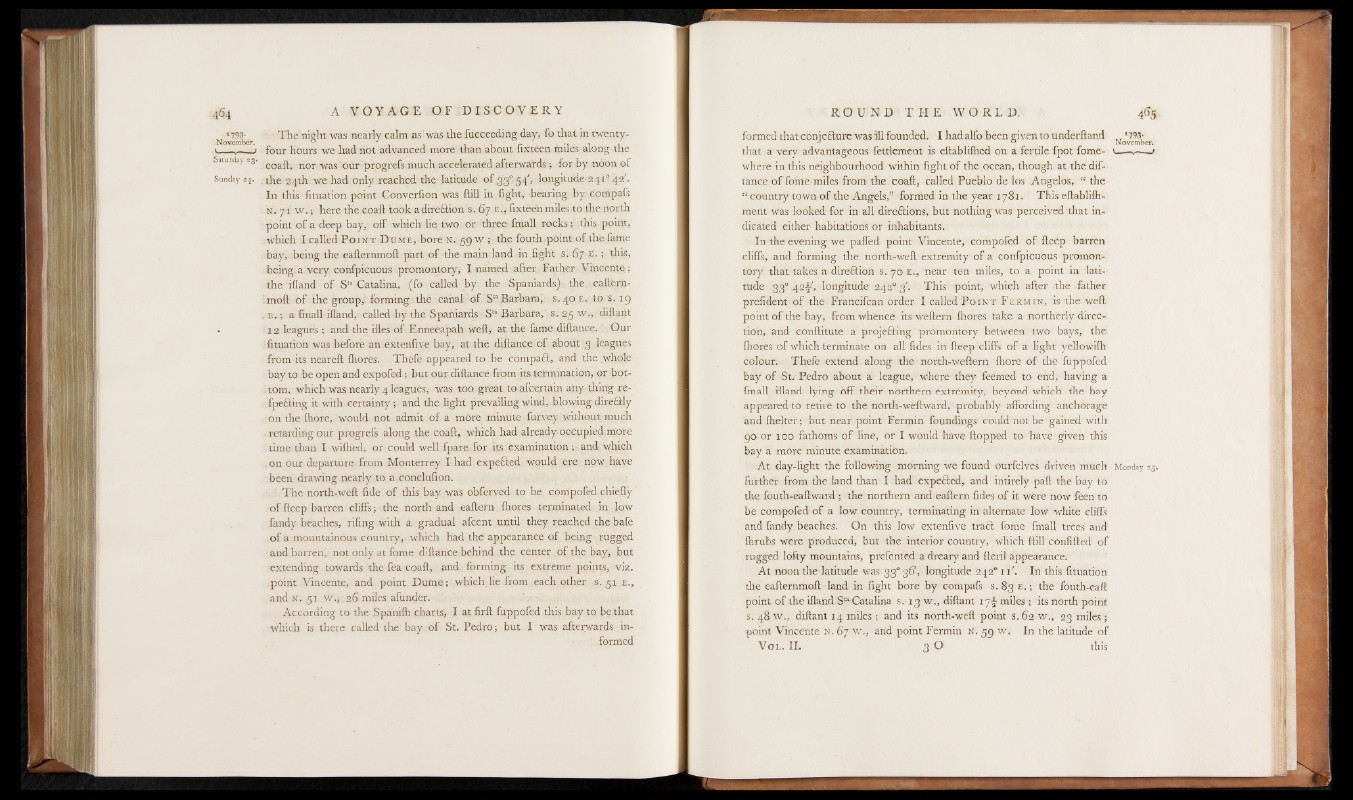
*« * The night was nearly calm as' was the fucceeding day, fo that in twen ty-
■ ’■ four hours we had not advanced more than about fixteen miles along the
Saturday 23. CQaj^ n(;)r was our progrefs much accelerated afterwards ; for by noon of
Sunday 24. the 24th we had only reached the latitude of 33° 54', longitude 241° 42'.
In this fituation point Converfion was ftill in light, bearing by compafs
N. 71 w . ; here the coaft took a direction s. 67 E., fixteen miles to the north
point of a deep bay, off which lie two Or three fmali rocks; this' point,
which I called Point Dume, bore n. 59 w ; the fouth point of the fatne
bay, being the eaflernmoft part of the main land in light s. 67 0 -! this,
being a very cohfpicuous promontory, I named after Father Vincentes;
the ifland of SH Catalina, (fo called by the Spaniards); the. eaftern-
mofl o f the group, forming the canal of S“ Barbara, s. 40 E. to S. 19
, e . ; a fmali ifland, called by the Spaniards S'1 Barbara, s. 25 w., diflant
• 12 leagues ; and the files of Enneeapah weft, at the fame diftance. Our
fituation was before an extenfive bay, at the diftance o f about 3 leagues
from its neareft fhores. Thefe appeared to be com pad, and the .whole
bay to be open and expofed; but our diftance from its termination, or bottom,
which was nearly 4 leagues, was too great to afeertain airy thing re-
fpe&ing it with certainty ; and the light prevailing wind, blowing directly
on the fhore, would not admit of a more minute furvey without much
retarding our progrefs along the coaft, which had already occupied more
time than I wifhed, or could well fpare for its examination ; and; which
. on our departure from Monterrey I had expected would ere now have
been drawing nearly to a conclufion.
The north-weft fide of this bay was obferved to be compofed chiefly
o f fteep barren cliffs; the north and eaftern fhores terminated in low
Tandy beaches, riling with a gradual afeent until they reached thebafe
o f a mountainous country, which had the appearance' of being rugged
and barren, not only at fome diftance behind the center of the bay, but
extending towards the fea coaft, and forming its extreme points, viz.
point Vincente, and point Dume; which lie from each other s. 51 e.,
and N. 51 w., 26 miles afunder.
According to the Spanifh charts; I at firft fuppofed this bay to be that
■ which is there called the' bay o f St. Pedro; but I was afterwards informed
formed that conieClure was ill founded. I hadalfobeen J _ 0g iven to underftand No*ve•»m*b-er.
that a very advantageous fettiement is eftablifhed on a fertile fpot fome- ,— -/
where in this neighbourhood within fight of the ocean, though at the diftance
of fome miles from the coaft, called Pueblo de los Angelos, “ the
“ country town o f the Angels,” formed in the year 1781. This eflablifh-
ment was looked for in all direftions, but nothing was perceived that indicated
either habitations or inhabitants.
In the evening we palled point Vincente, compofed o f fteep barren
cliffs, and forming the north-weft extremity of a confpicuous promontory
that takes a direction s. 70 e., near ten miles, to a point in latitude
33“ 42-j, longitude 2420 3'. This point, which after the father
prefident o f the Francifcan order I called Point Fermin, is the weft
point of the bay, from whence its weftern fhores take a northerly direction,
and conflitute a projecting promontory between two bays, the
fhores of which terminate on all (ides in fteep cliffs of a light yellowifh
colour. Thefe extend along the north-weflern fhore of the fuppofed
bay of St. Pedro about a league, where they feemed to end, having a
fmali ifland lying off their northern extremity, beyond which the bay
appeared to retire to the north-weftward, probably affording anchorage
andfhelter; but near point Fermin foundings could not be gained with
go or 100 fathoms o f line, or I would have flopped to have given this
bay a more minute examination.
A t day-light the following morning we found ourfelves driven much Monday 25.
further from die land than I had expected, and intirely paft the bay to
the fouth-eaftward ; the northern and eaftern fides of it were now feen to
be compofed o f a low country, terminating in alternate low white cliffs
and fandy beaches. On this low extenfive tract fome fmali trees and
fhrubs were produced, but the interior country, which ftill confifled of
rugged lofty mountains, prefented a dreary and fteril appearance.
At noon the latitude was 33° 36', longitude 242" 11'. In this fituation
the eaflernmoft land in fight bore by compafs s. 83 e. ; the fouth-eafl
point of the ifland Su Catalina s. 13 w ., diflant iff® miles ; its north point
s. 48 w ., diflant 14 miles ; and its north-well point s. 62 w., 23 miles ;
point Vincente n. 67 w., and point Fermin n. 49 w . In the latitude of
Vert. II. 3 O this